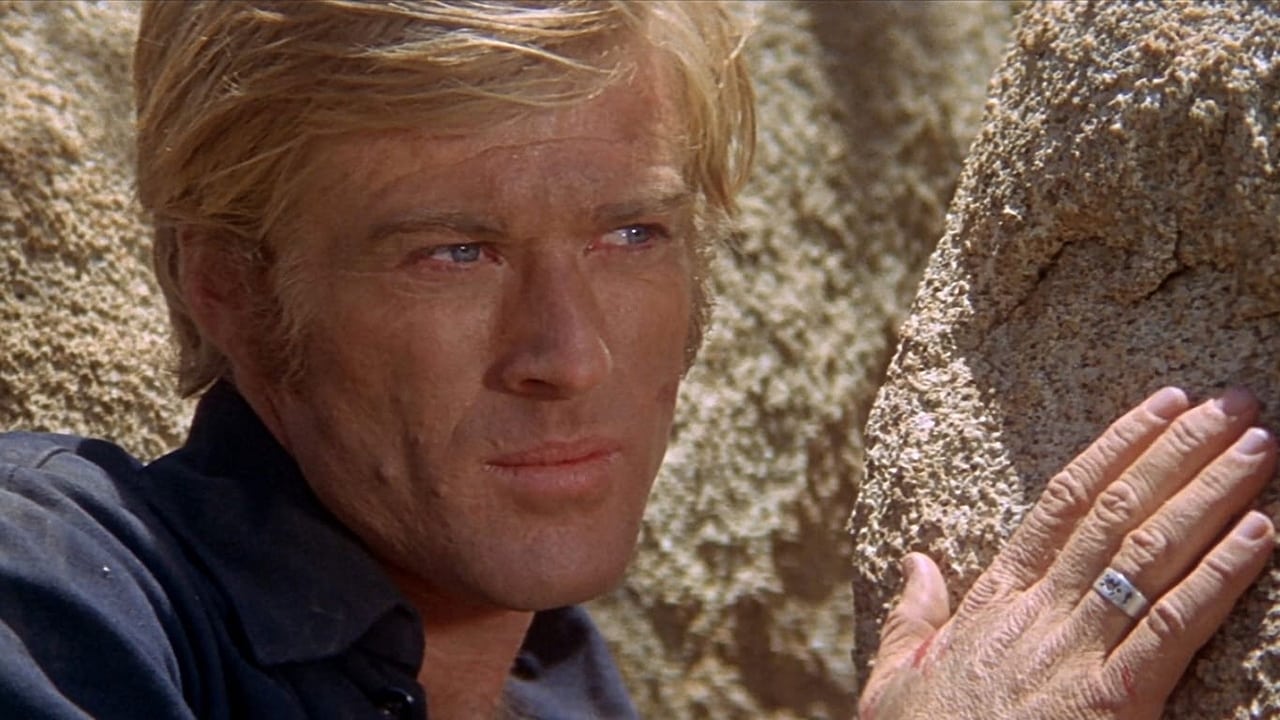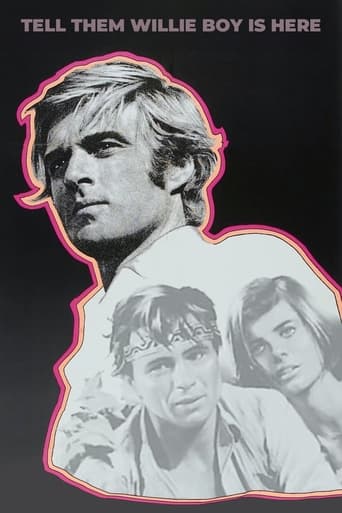

Very well executed
... View MoreSave your money for something good and enjoyable
... View MoreThe movie runs out of plot and jokes well before the end of a two-hour running time, long for a light comedy.
... View MoreYes, absolutely, there is fun to be had, as well as many, many things to go boom, all amid an atmospheric urban jungle.
... View MoreHere is the true account of this story as told by posse member Law-man Ben de Crevecoeur in 1941.Willie Boy was a 25 or 26 year old Paiute Indian. Isoleta Boniface was a 15 year old Paiute Indian girl. Isoleta's father, Old Mike Boniface was a Paiute Indian.Willie Boy had an unrequited interest in Isoleta. Her father didn't like Willie Boy. Willie Boy kidnapped Isoleta the first time from the family's camp at Twenty-nine Palms, Ca. Her father found them, took her back and told Willie Boy that if he came near her again he would kill Willie Boy.Some days later, after drinking with a White friend, Willie Boy went to the Gillman Ranch, near Banning Ca., where the Boniface family was working and crept up on Old Mike, his wife and their 7 children where they were sleeping under a Cottonwood tree. Willie Boy shot Old Mike in the head as he slept.Willie Boy kidnapped Isoleta again and headed into the desert. He used her as a pack animal to carry whatever supplies he had. The posse, some of which were Paiute Indians, came upon a message scrawled in the dirt from Isoleta that read, "My heart is almost gone, I will be dead soon". When she couldn't go any further, Willie Boy shot her in the back and killed her.Lawman Ben Crevecouer said, "The sight of that girl's body was something a person would want to forget, but couldn't. We came on it while it was still warm. Her clothes were just rags, she was welts and bruises all over, and there were cactus spines in her flesh. She had worn through her thin little shoes and her feet were raw and bloody".The posse eventually discovered Willie Boy's body after chasing him for 11 days and 500 to 600 miles in Riverside and San Bernardino Counties in Ca.. Willie Boy killed himself with his last bullet.Willie Boy was just a scumbag who murdered two of his own people but ,of course, this director, Abe Polonsky, turns the story into another anti-White Hollywood propaganda film.Info from interview of Ben de Crevecouer in "Desert Magazine", Nov. 1941.
... View MoreApparently, a seriously fictionalized adaptation of the saga of troubled Paiute "Willie Boy", transforming it into a Romeo and Juliet-like tale, with Willie(Robert Blake) and his half-breed girlfriend, Lola(Katherine Ross), the victims of racial slurs and prejudice by judicial authorities. In part, it's also a standard western, with a long posse chase of this horseless fugitive and his girl through a rocky desert wilderness in southern CA, followed by a hide and seek shooting duel with Deputy Sheriff Coop(Robert Redford) on a bare rocky Ruby Mountain. The ultimate outcome was quite predictable.Willie much resents being considered inferior to white men, and often being referred to as 'boy'. Once in a while, he strikes back like a rattler. He jabs a belittling bigot in a pool hall, causing serious injury. He refuses to give up his courting of half-breed Lola, despite murderous threats by her disapproving father. When this duo disappear one night, her father and 2 other men with rifles go looking for them in the woods, and find them making love. As papa appears ready to shoot Willie, he grabs his rifle and shoots papa first. The other men scatter. Seems like Willie should have been able to plead self-defense, with Lola a witness. Apparently, they(rightly) didn't think that would be good enough for a white judge. Thus, they run into the wilderness, and a posse is organized to capture them.Dr. Lisa Arnold(Susan Clark) is the 4th main character. She has earned a doctorate at a prestigious eastern university, and is a medical doctor as well as the superintendent of this reservation. Apparently unmarried, she treats the 'Indians' as her surrogate children, to be protected from the big bad outside world(especially illegal whiskey salesmen). She has a dysfunctional sexual relationship with Coop, refusing to acknowledge him outside her bedroom, as she considers him her social and intellectual inferior. Since Willie's Lola has been raised to be a white woman, Willie is also seen by most as her social inferior.The fact that Willie, from a high vantage point, shot at only the horses, not the men, of the posse, suggests that he did not shoot men unless he felt he absolutely had to. However, in his subsequent shooting duel with Coop, he definitely was shooting to kill.The details of the final duel between Coop and Willie are perhaps significant to the story. Coop surprises Willie from behind, and gives him a chance to surrender. But Willie whirls around, with rifle ready to fire. Coop shoots him dead. But Coop discovers that Willie's rifle was empty. Hence, Willie's action was actually an indirect suicide, thus mimicking the apparent earlier Lola suicide. Coop's action was in apparent self-defense, as was Willie's earlier shooting of Lola's father. However, Coop is regarded as a hero, whereas Willie rightly assumed that he would be regarded by white authorities as an unjustified murderer.The film ends with Willie's body being cremated at the base of Ruby Mountain, where he died. Interestingly, Coop gave the body to the Paiute present, telling them to bury it. Instead, they gathered wood for a funeral pyre. When the white posse arrived, they object that they want a body to show to authorities to prove that Willie is indeed dead. Coop obviously supports the Paiute's decision, saying "Tell them we're all out of souvenirs". In that era, the bodies and effects of infamous outlaws were often subject to theft by souvenir hunters. Presumably, that's part of Coop's thinking. Also, he was telling the posse to let the Paiute dispose of the body according to their traditions. According to Gary Varner's web site titled "The Treatment of Death Among the Paiute", both burial and cremation were commonly practiced, according to circumstances. Willie's circumstance could call for cremation.For one thing, burning was believed to neutralize evil associated with a person and the potential mischief by their ghost(also true of the witch burnings in Europe). Actual accounts of Willie's death favor cremation on site, although another account claims that he escaped captureAccording to one reviewer and several web sites I consulted, the real Willie clearly murdered Lola's father, who was a Paiute shaman. She was either a voluntary or involuntary companion during his flight, depending on the account. Lola was either murdered by Willie or accidentally shot by the posse, depending on the account. Willie died alone on Ruby mountain, maybe. The Coop and Dr. Arnold characters are pure inventions. Thus, the most important details of the film are all fabrications, despite the claim at the beginning that it is a true story. Typical Hollywood! I thought the President Taft episode was an unnecessary diversion from the main story. The main characters, with the possible exception of Katherine Ross, were well cast. For a much more fun role for Susan Clark, see "The Skin Game", in which she is a pickpocket-con artist nemesis-companion for James Garner.
... View MoreTELL THEM WILLIE BOY IS HERE has top-notch color photography by Conrad Hall, a thinking man's script that is character driven, and good performances all around by a cast that includes ROBERT REDFORD, ROBERT BLAKE, SUSAN CLARK, BARRY SULLIVAN and KATHARINE ROSS. But it's a lumbering tale that takes a good hour before the dust begins to settle and we get some action along with the character development of both Blake and Redford.Every scene is painfully slow in getting to the payoff so that the film seems a lot longer than one hour and thirty-six minutes. The first hour is devoted to the manhunt for an Indian killer (Blake) and then the plot involves the arrival of President Taft in 1909 California and the effort to protect him from any kind of assassination attempt.Redford's role as the reluctant sheriff is never too clear since he's a man of a very few words (a regular Gary Cooper type), so it's up to Blake to carry much of the film and he does. He's terrific as the Indian lad who's trigger happy when the posse starts getting too close.The last twenty minutes should have been a model of suspense as they close in on Willie Boy, but it's allowed to drag out interminably.Summing up: Character driven tale had the potential to be a fine western, but badly paced direction of Abraham Polonsky is no help nor is the sluggish script. Film was released after BUTCH CASSIDY AND THE SUNDANCE KID put Redford on the map but was never a big box-office success.
... View Morethe first time i saw this movie i was a pre-teen, and it always haunted me. i think it should have gotten a much higher rating also.yes, it raises all the cross-culture misunderstandings, thats what makes it so tragic and so good. it makes you stop and think before you make that next assumption about someone you don't know....whose culture your only vaguely familiar with..not a bad thing to do today, then or anytime.
... View More